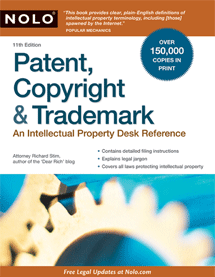New Book Review: "Patent, Copyright & Trademark"
New book review for Patent, Copyright & Trademark: An Intellectual Property Desk Reference (11th Edition), by Attorney Richard Stim, NOLO, 2010:


Copy provided by Amazon.
Good introduction to intellectual property law, which consists of four separate and overlapping legal disciplines: (1) patent law, (2) copyright law, (3) trademark law, and (4) trade secret law. Following an introduction that provides a high-level overview of intellectual property law, the remainder of the text is broken down into each of these disciplines, with the bulk dedicated to patent law and copyright law. Each of these sections provides an overview of the discipline covered, along with definitions associated with the corresponding discipline and explanations of forms that need to be filed, together with sample completed examples, followed by the actual legal statutes.
While the bulk of what Stim provides here is dedicated to patent law and copyright law, definitions are what carry this text across all of the four disciplines. That definitions comprise a majority of this text is important, because depending on the needs of the reader this may or may not be an effective format. This book is one of a number of self-help legal resources that Nolo provides, and so it is important to realize that this 600-page effort should probably be seen as just a good place to start one's journey in intellectual property. At the same time, it is also likely that the reader will not need to read this book cover-to-cover, because Nolo publishes separate texts dedicated to each of the four disciplines covered here.
Nolo has been updating this text regularly since the mid-1990s, so the reader can be assured that the content that is provided is up-to-date at time of publication. In each of the overview sections, Stim provides several pages under the header "What's new in patent law since the last edition?" that explain the major events in each respective discipline since the last edition of the book was published. In my opinion, this information mainly serves as a reminder that the law continues to evolve, and is probably best used by the reader as a starting point for further investigation, since the legal decisions provided are highly summarized. It is also worth pointing out that the author provides references to abundant web site resources that provide additional information.
The overviews and definitions are written clearly for those new to these legal disciplines. Compared to the last text I read on related subject matter, "Inventing Software: The Rise of 'Computer-Related' Patents" by Kenneth Nichols (see my review), I also find the material that this book provides to be very well organized. As a consultant in the software industry, the definitions that Stim provides for such terms as "algorithms", "software patents", "reverse engineering and trade secrets", and "software and trade secrets" are especially appreciated, and as a blog writer I also appreciated some of the tips that the author provides on copyrighted material. Recommended to anyone looking for an introductory text on intellectual property law.